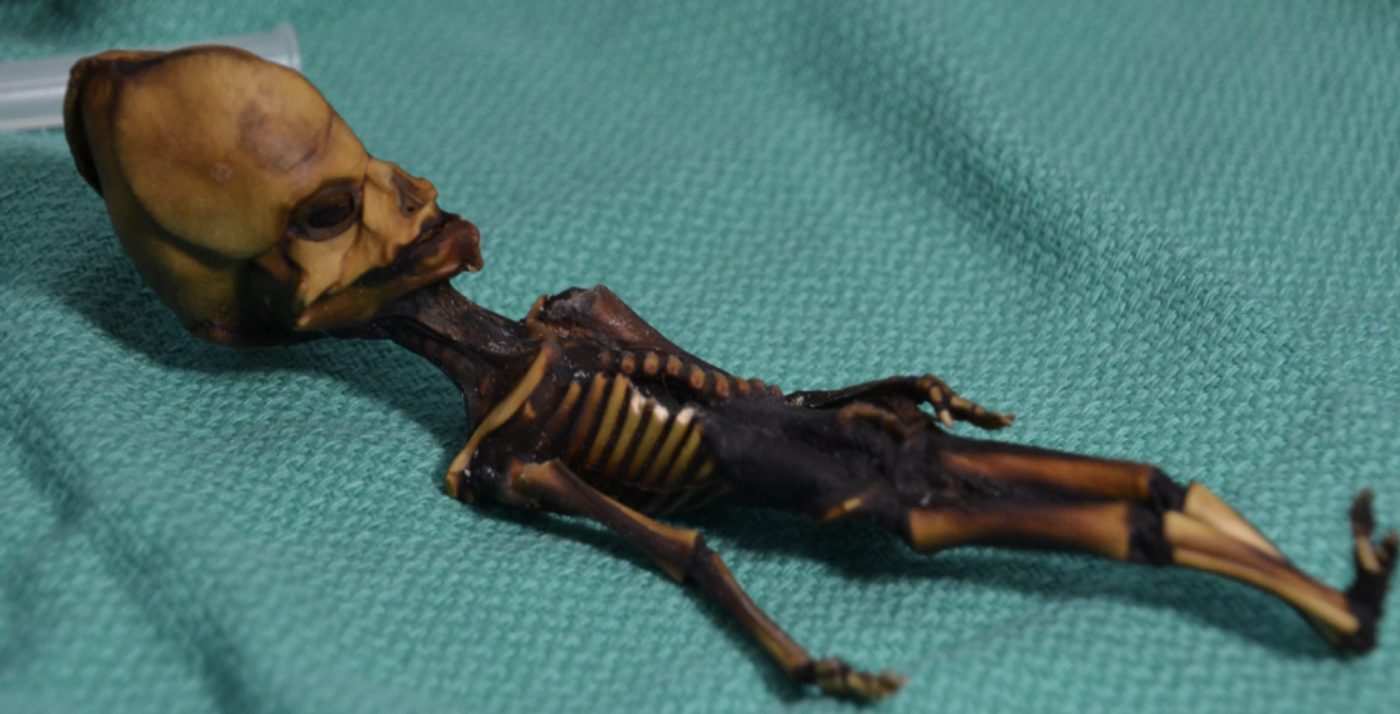Mystery Solved: The Atacama Skeleton is not an Alien
People had many theories about a small skeleton that was found behind an abandoned church in the Atacama Desert in Chile. The six-inch figure was recovered in a leather pouch and had a head shaped like a cone, only ten pairs of ribs and the bones of a child. It was nicknamed Ata, and she entered the black market, eventually, it was proposed to be an extraterrestrial. A new analysis of the remains by researchers at UC San Francisco and Stanford University has indicated, however, that it is human.
Reporting in Genome Research, the scientists found that the DNA carried by the skeleton was that of a modern human female, blending European and Native American ancestral markers just like people that now live in the area. There were also several genetic mutations in the genome that explain Ata’s appearance. These rare mutations have been linked to bone and growth disorders.
Powerful modern genetic tools have enabled researchers to eliminate guesswork and identify the small changes in the genome that resulted in Ata.
"The bioinformatics analyses in the paper showcase the power and wealth of information available in the public domain that led to the discovery of novel and rare deleterious variants in genes associated with Ata's phenotype," noted Sanchita Bhattacharya, first author and bioinformatics researcher at the UCSF Institute for Computational Health Sciences (ICHS). "The analysis was even more challenging with a very limited amount of information about the specimen, and lack of family history, which makes it a unique case."
For this work, Bhattacharya utilized a database that connects genomic data to characteristics seen in disease, the Human Phenotype Ontology (HPO). After a first pass, 64 gene variants were found that may have deleterious effects. After querying HPO, Bhattacharya was amazed to see that many of the potential problems related to skeletal dysfunction, including "proportionate short stature" and "11 pairs of ribs."
"The moment I saw it, I could see there was something interesting going on there," Bhattacharya said. "It was a little amount of information, and I am not a bone expert. This was a very blinded analysis."
Genes are made up of strings of nucleotide bases, and small changes often happen in genes, to only individual nucleotides. Some of those single nucleotide variations are relatively common and are called single nucleotide polymorphisms. Others may happen to just one or any unspecified number of people, and they are called single nucleotide variants (SNVs). This work revealed six new SNVs; four in genes that cause bone disease, two in genes that relate to collagen production.
The genomic analysis of Ata may be esoteric, but it points to the possibilities that clinical genetics will present in the future, noted Atul Butte, MD, Ph.D., who directs ICHS and is the Priscilla Chan and Mark Zuckerberg Distinguished Professor at UCSF.
Rather than starting from symptoms and trying to find a diagnosis, scientists and doctors may one day take genomic data and work from that to see where abnormalities exist.
"Analyzing a puzzling sample like the Ata genome can teach us how to handle current medical samples, which may be driven by multiple mutations," Butte said. "When we study the genomes of patients with unusual syndromes, there may be more than one gene or pathway involved genetically, which is not always considered."
Garry Nolan, Ph.D., a professor of microbiology and immunology at the Stanford University School of Medicine started investigating the mystery of Ata in 2012 after a friend called and said he might have identified an "alien."
Nolan suggested that additional research investigating Ata could have a benefit to patients one day. "Maybe there's a way to accelerate bone growth in people who need it, people who have bad breaks," he said. "Nothing like this had been seen before. Certainly, nobody had looked into the genetics of it."
Nolan is hopeful that Ata will get a proper burial one day. He added that the skeleton is probably less than 40 years old, based on its condition.
"We now know that it's a child, and probably either a pre- or post-term birth and death," he said. "I think it should be returned to the country of origin and buried according to the customs of the local people."
Sources: AAAS/Eurekalert! Via University of California San Francisco, Genome Research



![WGS for rare disease diagnosis [eBook]](https://d3bkbkx82g74b8.cloudfront.net/eyJidWNrZXQiOiJsYWJyb290cy1pbWFnZXMiLCJrZXkiOiJjb250ZW50X2FydGljbGVfcHJvZmlsZV9pbWFnZV84MmRlM2UyYjA5M2Q3ZTYwOTI3Zjc1YTRjOWU2N2RmMjkzMThjMTJkXzI1MDcucG5nIiwiZWRpdHMiOnsidG9Gb3JtYXQiOiJqcGciLCJyZXNpemUiOnsid2lkdGgiOjcwMCwiaGVpZ2h0IjozNTAsImZpdCI6ImNvdmVyIiwicG9zaXRpb24iOiJjZW50ZXIiLCJiYWNrZ3JvdW5kIjoiI2ZmZiJ9LCJmbGF0dGVuIjp7ImJhY2tncm91bmQiOiIjZmZmIn19fQ==)





